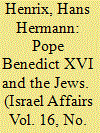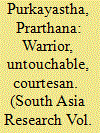| Srl | Item |
| 1 |
ID:
100681


|
|
|
|
|
| Publication |
2010.
|
| Summary/Abstract |
The article deals with the question of whether the view that Benedict's relationship with the Jews needs to be regarded with suspicion is justified. Ratzinger's respective theology is scrutinized. Special attention is given to the contested Good Friday prayer for Jews as well as to the attempt at re-integrating the priests of the Pius X priest community. It cannot be denied that there is suspicion and ambiguity. In Benedict's view the fact that Israel is the foundation of Christian faith has been overshadowed. This firm belief has been expressed in Benedict's book on Jesus of Nazareth, during his visit to Israel in May 2009, and also during his address to the Jewish community in Rome in January 2010. The latter event is of particular importance. Benedict's address of 17 January 2010 can be seen as a central hermeneutical point of reference to understand Benedict's relationship with Judaism and the Jews. It is in the light of this point of reference that moments of suspicion can be counteracted. This does not mean, however, that Catholic-Jewish relations have been without irritations and tensions. But there is space for a constructive way of dealing with these frictions.
|
|
|
|
|
|
|
|
|
|
|
|
|
|
|
|
| 2 |
ID:
091734


|
|
|
|
|
| Publication |
2009.
|
| Summary/Abstract |
This article analyses the intimate links between dance and the processes of national and postcolonial identity formation in India, particularly in Bengal, in the twentieth century. It examines alternative, non-classical artistic experiments in the realm of theatre dance spawned by twentieth century cultural nationalism in India, focusing on dancing bodies that actively engaged with, and wrote different meanings for, the socio-political space they inhabited. Dance-dramas written by Rabindranath Tagore in the 1930s are used as points of entry into a discourse on South Asian modernism and feminism, opening up a space in which the twentieth century representation of Indian women through bodily performance troubles notions of cultural purity and origin and offers instead 'impure' but nevertheless powerful cultural texts.
|
|
|
|
|
|
|
|
|
|
|
|
|
|
|
|